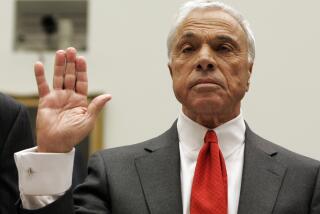S&Ls; Must Act Now to Weather Next Slump
- Share via
Because of falling interest rates, this could be the savings and loan industry’s best year ever, with profits predicted to reach $6 billion. But despite that prediction, several hundred thrifts are poised on the brink of collapse--hardly an auspicious situation considering that the economy is three years into a recovery that appears to be slowing down.
Why are so many S&Ls; in trouble? Because the basic nature and environment of the industry has changed dramatically in the past few years and many thrifts simply have not adapted.
Gone are the easy years when S&Ls; accepted 5% passbook deposits, then lent the money out as home mortgages for several percentage points more. With deregulation and soaring interest rates in the late 1970s, S&Ls; were forced to pay higher rates to hold their deposits. But the thrifts held billions in low-yield, fixed-rate mortgages. Between 1981 and 1982, the S&L; industry lost close to $9 billion.
In response to that crisis, Washington permitted the thrifts to lower their minimum capital requirements, make new kinds of loans and enter real estate development. And many beleaguered S&Ls; enthusiastically embraced these new powers.
Extreme Business Ventures
Searching for new opportunities, some associations got involved in rather extreme business ventures such as financing corporate takeovers, fast food restaurant ownership and even funeral homes. Others embarked upon real estate development, joint venture development and syndication.
With these new endeavors, the S&Ls; had entered a competitive arena where other major players had more experience. In their eagerness to generate profits quickly from their high-cost deposits, some thrifts’ managers fell into a “have money, must spend” mentality.
How can we alleviate this crisis that threatens the stability of the nation’s financial system? So far, the Federal Home Loan Bank Board, which regulates the nation’s thrifts, has arranged shotgun mergers or offered investors incentives to take control of failing associations.
Under the present circumstances, this course of action often does our financial system more harm than good. Embattled managers may be tempted to make even riskier loans or development deals, all with the knowledge that the Federal Savings & Loan Insurance Corp. will protect the depositors if this last-minute turnaround attempt fails.
To ensure their survival without getting a blank check from Washington, the S&Ls; must transform themselves into truly diversified financial services institutions that offer corporate and industrial loans, stock brokerage, insurance and expanded consumer lending.
However, entering into or expanding these businesses will not enable most S&Ls; to regain their former strength overnight. Intense competition from banks, investment banking firms and retailing giants such as Sears means that this strategy will not come to fruition at least until the next decade. Yet, it is one that must be implemented now if the thrifts are to gain the necessary experience and momentum to compete effectively.
Existing Strengths
While working off their low-yield, fixed-rate mortgage portfolios, the S&Ls; should take advantage of their existing strengths--their good names, branch networks and ability to raise capital--and expand further into real estate joint ventures, syndication and mortgage banking.
Real estate joint ventures, which S&Ls; have funded since the early 1970s, offer the ideal marriage of a thrift’s equity investment and a developer’s experience. But the S&Ls; must begin to attract--and keep by paying well--managers who truly understand the real estate industry.
In addition, the industry must pursue the syndication of investments through limited partnerships--whether in real estate, research and development, or oil and gas, to name a few.
Finally, the thrifts should expand their mortgage-banking activity, already a profitable source of income for some S&Ls.;
Mortgage banking, which involves making mortgages and then selling them into a secondary market, which includes the government (Federal National Mortgage Assn.) and larger financial institutions, is a relatively risk-free way of expanding upon the associations’ traditional residential lending activity yet shedding much of its potential downside. Moreover, it provides a source of long-term income from servicing the mortgages.
The S&Ls; cannot depend forever on external factors, such as falling interest rates, to keep them in the black.
If the country falls into another recession, the anticipated profits of this year could once again become the massive losses the industry saw several years ago. Therefore, there’s not a moment to be lost in taking preventive steps. The clock is ticking, and for those thrifts that do not begin to make changes now, it will soon be too late for them to start.
More to Read
Inside the business of entertainment
The Wide Shot brings you news, analysis and insights on everything from streaming wars to production — and what it all means for the future.
You may occasionally receive promotional content from the Los Angeles Times.










